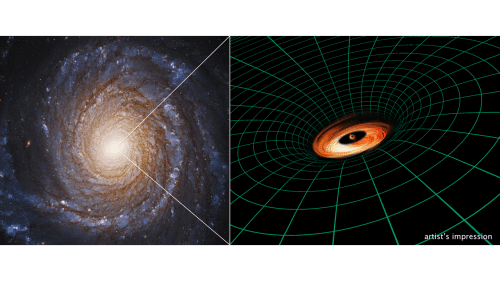An international research team, in which Prof. Ari Laur from the Faculty of Physics at the Technion is a partner, was surprised to discover in the galaxy NGC 3417 a disk of gas whose existence contradicts the accepted astrophysical predictions. The discovery is based on observations by the Hubble Space Telescope

Like the other members of the international team in which he is a partner, Prof. Ari Laur from the Faculty of Physics at the Technion was surprised by the central finding of the observation made by the team on May 17, 2018: the existence of a gas disk in a place where it should not have been found according to the accepted astrophysical theories. The discovery of the surprising disk around the black hole at the center of the galaxy NGC 3417, located 130 million light years from us, was made using the Hubble Space Telescope.
According to Prof. Laor, "We observed the center of the galaxy NGC 3147, where we found a massive black hole whose mass is 300 million times greater than the mass of our Sun. Contrary to all predictions, we discovered there a thin disk of gas rotating at an enormous speed - more than a tenth of the speed of light - very close to the black hole."
Massive black holes are at the center of most galaxies, but only a small number of galaxies have an accretion disk through which the gas falls into the black hole. In this process, radiation is released that may exceed in intensity the radiation from all the stars in the galaxy.
In the galaxy NGC 3147, the black hole suffers from "malnutrition"; A very small amount of gas reaches the center and produces only a tiny amount of radiation. In this case the gas is expected to remain thin and diffuse and not form the disk structure. According to Prof. Laur, "We considered the black hole of NGC 3147 as a perfect candidate to confirm the theory that, below certain luminosities, the absorption disk ceases to exist. What we saw was completely unexpected: we found gas swirling around the black hole, whose properties cannot be explained without the existence of a thin accretion disk near the black hole.”
The disc that was discovered is in the depth of the black hole's gravitational field, so that the gravitational field deflects the light to longer wavelengths - a process called redshift. Due to the high speeds, there is also an opposite effect that diverts some of the light to shorter wavelengths. According to the lead author of the study, Stefano Bianchi from the University of Rome, "The disk we discovered is so close to the black hole that the strength of gravity and the speed of the gas significantly affect the light particles, and we will not be able to understand the information collected if we do not include the effects of special and general relativity." According to Marco Chiaberga, who participated in the study, "we have never seen with such clarity, and in such a visible light, effects of both special relativity and general relativity." Cyaberge is a researcher at the European Space Agency, the Space Telescope Science Institute and Johns Hopkins University. The overall effect creates a characteristic signature for a relativistic gas moving around a black hole, a signature that Prof. Laor calculated in 1991. The measured effects do exactly match the theoretical calculation.
The dramatic discovery is based, as mentioned, on observations made by the Hubble Space Telescope using a device called a spectrograph. This device makes it possible to accurately measure the velocity distribution of the gas emitting radiation. According to the researchers, "Without a space telescope, we cannot make the observation, because the luminosity of the stars in the galaxy exceeds the relatively weak radiation emitted by the black hole by dozens of times. The high angular separation of the space telescope made it possible to isolate and measure the radiation from the vicinity of the black hole only."
The researchers hope to find, using the Hubble, similar thin disks near black holes in other galaxies, and learn with this method about the structure of the disks and possibly even about the rotation of the black hole itself.
Prof. Ari Laur is an astrophysicist specializing in black holes. In 1995 he joined the faculty of physics at the Technion after a doctorate at Tel Aviv University and a post-doctorate at Princeton and the California Institute of Technology.
